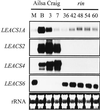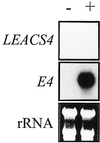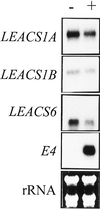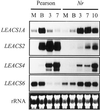The regulation of 1-aminocyclopropane-1-carboxylic acid synthase gene expression during the transition from system-1 to system-2 ethylene synthesis in tomato
- PMID: 10889246
- PMCID: PMC59060
- DOI: 10.1104/pp.123.3.979
The regulation of 1-aminocyclopropane-1-carboxylic acid synthase gene expression during the transition from system-1 to system-2 ethylene synthesis in tomato
Abstract
1-Aminocyclopropane-1-carboxylic acid synthase (ACS) is one of the key regulatory enzymes involved in the synthesis of the hormone ethylene and is encoded by a multigene family containing at least eight members in tomato (Lycopersicon esculentum). Increased ethylene production accompanies ripening in tomato, and this coincides with a change in the regulation of ethylene synthesis from auto-inhibitory to autostimulatory. The signaling pathways that operate to bring about this transition from so-called system-1 to system-2 ethylene production are unknown, and we have begun to address these by investigating the regulation of ACS expression during ripening. Transcripts corresponding to four ACS genes, LEACS1A, LEACS2, LEACS4, and LEACS6, were detected in tomato fruit, and expression analysis using the ripening inhibitor (rin) mutant in combination with ethylene treatments and the Never-ripe (Nr) mutant has demonstrated that each is regulated in a unique way. A proposed model suggests that system-1 ethylene is regulated by the expression of LEACS1A and LEACS6. In fruit a transition period occurs in which the RIN gene plays a pivotal role leading to increased expression of LEACS1A and induction of LEACS4. System-2 ethylene synthesis is subsequently initiated and maintained by ethylene-dependent induction of LEACS2.
Figures






Similar articles
-
Regulation of ethylene biosynthesis in response to pollination in tomato flowers.Plant Physiol. 2000 Jul;123(3):971-8. doi: 10.1104/pp.123.3.971. Plant Physiol. 2000. PMID: 10889245 Free PMC article.
-
Ethylene biosynthesis regulation in tomato fruit from the F1 hybrid of the ripening inhibitor (rin) mutant.Biosci Biotechnol Biochem. 2006 Jul;70(7):1769-72. doi: 10.1271/bbb.50611. Biosci Biotechnol Biochem. 2006. PMID: 16861812
-
Ripening-associated ethylene biosynthesis in tomato fruit is autocatalytically and developmentally regulated.J Exp Bot. 2009;60(12):3433-42. doi: 10.1093/jxb/erp185. Epub 2009 Jul 15. J Exp Bot. 2009. PMID: 19605457 Free PMC article.
-
Ethylene biosynthesis and action in tomato: a model for climacteric fruit ripening.J Exp Bot. 2002 Oct;53(377):2039-55. doi: 10.1093/jxb/erf072. J Exp Bot. 2002. PMID: 12324528 Review.
-
Ethylene Control of Fruit Ripening: Revisiting the Complex Network of Transcriptional Regulation.Plant Physiol. 2015 Dec;169(4):2380-90. doi: 10.1104/pp.15.01361. Epub 2015 Oct 28. Plant Physiol. 2015. PMID: 26511917 Free PMC article. Review.
Cited by
-
Increased ACS Enzyme Dosage Causes Initiation of Climacteric Ethylene Production in Tomato.Int J Mol Sci. 2022 Sep 15;23(18):10788. doi: 10.3390/ijms231810788. Int J Mol Sci. 2022. PMID: 36142701 Free PMC article.
-
Comprehensive RNA-Seq Analysis on the Regulation of Tomato Ripening by Exogenous Auxin.PLoS One. 2016 May 26;11(5):e0156453. doi: 10.1371/journal.pone.0156453. eCollection 2016. PLoS One. 2016. PMID: 27228127 Free PMC article.
-
Distribution of MdACS3 null alleles in apple (Malus × domestica Borkh.) and its relevance to the fruit ripening characters.Breed Sci. 2012 Mar;62(1):46-52. doi: 10.1270/jsbbs.62.46. Epub 2012 Mar 20. Breed Sci. 2012. PMID: 23136513 Free PMC article.
-
Transcriptome and selected metabolite analyses reveal multiple points of ethylene control during tomato fruit development.Plant Cell. 2005 Nov;17(11):2954-65. doi: 10.1105/tpc.105.036053. Epub 2005 Oct 21. Plant Cell. 2005. PMID: 16243903 Free PMC article.
-
Developmental gene regulation during tomato fruit ripening and in-vitro sepal morphogenesis.BMC Plant Biol. 2003 Aug 7;3:4. doi: 10.1186/1471-2229-3-4. BMC Plant Biol. 2003. PMID: 12906715 Free PMC article.
References
-
- Abeles FB, Morgan PW, Saltveit ME. Ethylene in Plant Biology. San Diego: Academic Press; 1992.
-
- Barry CS, Blume B, Bouzayen M, Cooper W, Hamilton AJ, Grierson D. Differential expression of the 1-aminocyclopropane-1-carboxylate oxidase gene family of tomato. Plant J. 1996;9:525–535. - PubMed
-
- Blume B, Barry CS, Hamilton AJ, Bouzayen M, Grierson D. Identification of transposon-like elements in non-coding regions of tomato ACC oxidase genes. Mol Gen Genet. 1997;254:297–303. - PubMed
-
- Blume B, Grierson D. Expression of ACC oxidase promoter-GUS fusions in tomato and Nicotiana plumbaginifolia regulated by developmental and environmental stimuli. Plant J. 1997;12:731–746. - PubMed
Publication types
MeSH terms
Substances
LinkOut - more resources
Full Text Sources
Other Literature Sources

